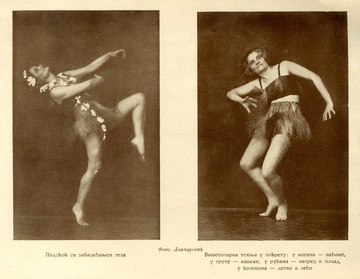Marija Maga Magazinović
1882–1968| Spouse | Gerhard Gesemann |
|---|---|
| Date of birth | October 14, 1882 |
| Date of death | 1968 |
| Web address |
Personal situation
Born in Užice, Serbia. She finished both primary school and gymnasium in Užice. She attended the Higher School for Girls in Belgrade, and the Faculty of Philosophy from 1898 to 1904. After graduation, she became the first female journalist in the newly founded newspaper Politika (Politics), now the oldest one in Serbia. She travelled to Germany in 1909, starting her education as a dancer. In 1912-13, during Balkan wars, Maga Magazinović was a nurse. Her marriage with the German Gerhard Gesemann lasted three years – from 1914 until 1916. Their son Harald-Rajko died early, and their daughter, Rajna Gesemann, was born in 1917. This is the time when Maga became acquainted with Rudolf von Laban's dance school. Upon her return to Belgrade, in 1919, she reopened her School for Rhythmic and Plastic. She had become a female gymnasium teacher in 1910, and was retired from the post in 1914. During her whole teaching career, and after retirement, Maga Magazinović was a dancer, teacher and theoretician of modern dance. She died in Belgrade, in 1968.
| Place of birth | Užice |
|---|---|
| Place(s) of residence | Germany, Serbia, and Switzerland |
| Place of death | Beograd |
| Nationality | Serbian |
| First language(s) | Serbian |
| Marital status | Divorced |
| Number of children | 2 |
| Name(s) of children | Harold-Rajko, Rajna |
| Gender of children | M (1) F (1) |
| Education | University education |
Professional situation
She was a feminist, an intellectual, a leftist, a teacher, a translator, a philosopher, and a professional journalist. She was the first Serbian woman who worked as a professional journalist in the oldest Serbian newspaper Politika. She was a professional dancer, a teacher of dancing (she led a school for rhythmic gymnastics for 25 years) and wrote a lot about rhythmic gymnastics, dance, and the female body. She belonged to the Belgrade intellectual circles from the beginning of the twentieth century. In 1920, together with Zora Prica, she established a school for recitation, foreign languages and aesthetic gymnastics, in Belgrade. Her work contributed to the modernization of the patriarchal society in Serbia at that time.
| Profession(s) and other activities | translator, philosopher, social-cultural activist, nurse, contributor to periodical press, teacher/governess, and actress |
|---|---|
| Language(s) in which she wrote | Serbian |
| Financial aspects of her career | Stipend/allowance/pension |
| Memberships | Of editorial boards |
Works by this author
Monographs
- Telesna kultura kao vaspitanje i umetnost 1932
- Vežbe i studije iz savremene gimnastike, plastike, ritmike i baleta: primenjena telesna kultura 1932
- Istorija igre 1951
- Moj život 2000
Articles and other similar texts
- Odnos umetničke igre prema muzici 1997
- Literatura o savremenoj telesnoj kulturi 1996
- Ruže 1907
- Pesnikinje: Kristina Ristićeva 1913
- Ritmička gimnastika 1913
- Učiteljice: Stanka Glišićeva 1913
- Pesnikinje: Danica Marković -Tatićeva 1913
- Učiteljice: Kosara Cvetkovićeva 1913
- Balet (deo 1) 1920.
- Balet (deo 2) 1920.
- Maks Rajnhart. (kraj) 1921.
- Maks Rajnhart. (1) 1921.
- Kostim igrača 1930
- Razmišljanje o budućoj ženskoj školi 1942
- Razmišljanja o budućoj ženskoj srednjoj školi 1942
- Školovanje u Beogradu 1965
- Detinjstvo u Užicu 1965
- Moje prvo sećanje 2019
- O apstraktnim idejama 2019
- O zakonima mišljenja 2019
- Telesno vaspitanje: ženska gimnazija 1912. godine 2019
Non-book materials/ Other material
- *Udžbenik iz ritmike 1951
Translations
Reception
Reception during lifetime
- Maga Magazinovićeva (1913)
- Ritmična gimnastika u nas (1920)
- Škola za ritmičku gimnastiku Mage Maganzinović; Rad škole od osnivanja do danas (1922)
- Godišnji matine Škole za Ritmiku i Plastiku g-đe Magazinović (1924)
- Srpska igra i pesma kao motiv umetničkog plesa (1927)
- Matine Škole g-đe Mage Magazinović (1928)
- Škola klasične i moderne ritmike gospođe Mage Magazinović-Gezeman (1932)
- Ein Leben für den Tanz (1935)
- 25-togodišnjica škole za ritmiku i plastiku g-đe Mage Magazinović (1935)
- Mi igramo: priručnik moderne narodne igre/ples (1957)
Reception after death
- Muzička enciklopedija (1974)
- Balet Narodnog pozorišta između dva svetska rata (1976)
- Nemoguće istorije (1992)
- Maga Magazinović 1882-1968. Prva lasta feminizma (1992)
- Prvih sedamdeset godina. Balet Narodnog pozorišta (1) (1994)
- Plastička umetnost Mage Magazinović (1996)
- Maga Magazinović: kontekst i značenja rada (1996)
- Portret prethodnice (1996)
- Sećanje na Magu Magazinović (1996)
- O studentkinjama iz Srbije na stranim univerzitetima do 1914. godine (1998)
- Maga Magazinović i modernost angažmana žene (1998)
- Marija Maga Magazinović (2000)
- Potisnuta istina – Kolaboracija u Srbiji 1941-1944 (2006)
- Oblikovanje kreativnog postupka – uticaji Maksa Rajhnarta i Isidore Dankan na Magu Magazinović (2008)
- Global, Local, Gen(d)eral (2009)
- Portret žene: Maga Magazinović (2010)
- Women Teachers in Serbia: Fiction and/as Life Stories (2010)
- Politika fizičke kulture, moderni ples i tri narativa o Magi Magazinović (2013)
Authors read by this author
* Only authors in Knjiženstvo DB are shown



